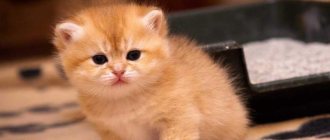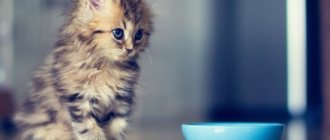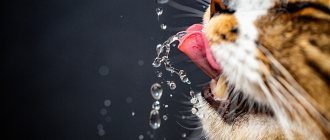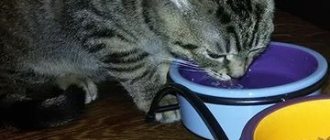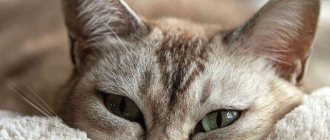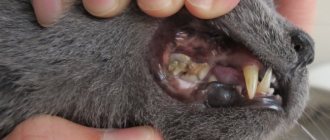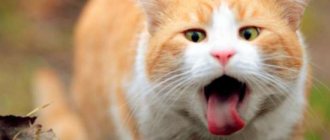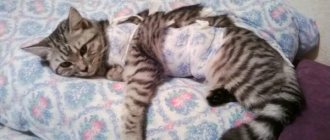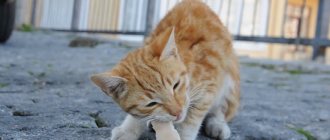Responsible owners always monitor the living conditions of their pets, so any oddities in behavior do not go unnoticed. It is very important to maintain a constant amount of food, water and vitamins. This is the only way the pet will remain healthy. That is why, when it is discovered that a cat drinks a lot of water, you need to quickly identify the cause and regulate the animal’s regime.
About the norm
Changing your pet's needs is not always a bad thing! Therefore, there is no need to panic if your cat drinks a lot of water. The reason may be completely harmless, and the consequences of changing the drinking regime will not affect the animal’s well-being at all. Felinologists do not have a definite figure for mandatory water consumption - this number depends on nutrition, climate, breed, age and many other factors.
Attention! Do not try to force water on a healthy cat! With rude actions you will not only not achieve the desired result, but will also frighten your pet. The animal, as a rule, knows very well how much water it needs!
Typically, veterinarians advise calculating the amount of required moisture so that there is 0.03 milliliters of liquid per gram of pet’s body weight. It doesn’t have to be just water; milk, canned food, and wet food will do.
It is very important to pay attention to your pet's diet. If a cat drinks a lot of water, the reasons may lie solely in a change in diet. Dry food tends to “pull” moisture from the animal’s body. Because of this, it is recommended to equalize the amount of water to the weight of food in a ratio of 1:3.
The cat drinks a lot of water and loses weight
Thirst and weight loss are a formidable pathological symptom.
The combination of thirst and weight loss develops in the following situations:
- poor nutrition;
- pathologies of the urinary tract;
- poisoning leading to vomiting and diarrhea;
- hormonal disorders;
- diabetes.
If a cat feeds on table scraps, a lot of salt and spices enter the body. When feeding only meat or fish, an excess of proteins occurs. The body spends a lot of energy processing such food, and the absorption of nutrients remains low.
When protein overfeeding, uric acid or other uric salts are formed, which are poorly soluble in blood or urine. If it is not possible to remove toxins, self-poisoning develops. That's why the cat drinks all the time. The struggle for survival comes to the fore; there is no time to digest the consumed food. To stop the intake of toxins, you need to stop eating.
In case of urolithiasis or cystitis, the primary task is to prevent salt crystallization. To prevent oversaturation of solutions, they are diluted with drunk water.
Be sure to read:
A kitten's eyes are watering: what to do, reasons, norm and pathology, characteristics of different breeds
In renal failure, the kidneys are unable to filter certain substances, such as phosphates. In elevated concentrations the compounds are poisonous. They have to be diluted. For the same reason, thirst occurs in diabetes mellitus: you need to dilute the glucose.
Diseases
Diabetes mellitus in a pet is one of the diseases that causes constant thirst. The cat's pancreas stops producing the required amount of the hormone insulin, which leads to problems delivering glucose to the cells. The necessary substance does not reach the kidneys in sufficient quantities. An important organ cannot filter moisture properly, and the cat quickly loses water.
Chronic renal failure is a very common incurable disease in older animals. Cells in an important organ cease to function normally and retain the required amount of moisture.
If your cat drinks a lot of water, then it is likely that you are experiencing one of the symptoms of hepatitis. The disease is caused by inflammatory processes in the liver. With proper treatment, the problem can be quite easily dealt with.
Attention! Many viral diseases and inflammatory processes are accompanied by increased thirst. Try to provide your pet with enough water so that his body continues to fight the disease.
Insulinoma (that is, inflammation of the pet's pancreas) is also accompanied by the fact that the cat often drinks water. The reasons for increased thirst also lie in excess insulin production. It is extremely rare in cats.
The cat drinks a lot of water: reasons
The causes of polydipsia are physiological and pathological.
The following reasons are considered physiological:
- Consumption of dry granules. The body of a mouse, the cat's main prey, contains about 30% dry matter. In dehydrated food - 90. Therefore, for every gram of granules consumed, you need to drink 90/30 = 3 g of water.
- Pregnancy, lambing and lactation require an increased amount of moisture to form amniotic fluid, restore lost fluid, and produce milk.
- High physical activity: the pet has played enough, runs around and drinks water greedily.
- Increased air temperature: the cat does not have sweat glands, it cannot cool itself by evaporation from the surface of the body. Therefore, you have to lick yourself intensively, wetting the fur with saliva. The second method of cooling is rapid breathing with an open mouth. Loss of moisture is compensated by increased drinking.
If your pet has no pathological symptoms, polydipsia is most likely due to physiological causes. However, the combination of thirst and painful symptoms is cause for concern.
Be sure to read:
What to do if pus comes out of your cat’s nose, what could it be, should you be afraid?
The following causes of polydipsia are considered pathological:
- Stressful situations: an inadequate situation with fear develops under the influence of stress noises. To reduce the adverse effects of biologically active components on the body, they need to be diluted and excreted in the urine.
- Eating human food. Unusual food contains an increased amount of table salt and dry matter.
- Diseases: polydipsia occurs with digestive disorders, diabetes, urolithiasis, renal and liver failure, poisoning, infections, infestations. Any pathological conditions are characterized by the accumulation of toxic metabolites in the blood, which must be gotten rid of as quickly as possible - diluted with water, removed with urine.
- Effect of medications. In some cases, diuretics are prescribed by a veterinarian. In other situations, side effects of medications develop. Increased fluid consumption causes thirst.
- Old age: Older animals develop many chronic diseases, the symptoms of which are difficult to notice individually, but collectively they manifest as polydipsia.
Natural causes
Often, owners, asking the question “Why does the cat drink a lot of water?”, unnecessarily dramatize the situation. Don’t forget about the completely natural (and harmless!) reasons for your pet’s increased need for water:
- increased physical activity (long walks, hyperactivity, playfulness, training);
- increased room temperature, stuffiness, hot season;
- pregnancy or lactation period;
- age (kittens practically do not need additional moisture, and older animals drink a lot);
- dietary habits (dry food or salted foods).
Don't worry or worry too much. If there are no other alarming symptoms in your pet’s behavior, then you just need to give your pet a little more water than usual.
Attention! It is necessary that the water in the drinking bowl is always fresh (changed every day). Do not give your pet tap water or distilled water. It is recommended to leave the filtered or boiled liquid in a bowl in a visible place. The pet must have free access to it.
How to train a cat to drink from a bowl?
Let's look at some ways to teach your pet to drink from a bowl:
- It is necessary to place a container with water at a distance from the dishes with food. After all, due to its instincts, a cat may refuse water due to its close location to food.
- The animal may not like the fact that the water is warm, so it is necessary to change it to cooler water more often.
- You can try replacing the water container itself. So, instead of a plastic container, put glass, porcelain or metal dishes. If your pet regularly turns over a bowl of water, you can offer him a more stable dish with a rubber base. Even the most playful and curious cat will not be able to turn over such a water container.
- There are also automatic waterers or drinking fountains that provide constant circulation of water. Due to the fact that water constantly passes through purifying filters, it remains clean and enriched with oxygen. This design allows the cat to drink water not only from a bowl, but also from the tap.
- You can try offering your cat different types of water. Perhaps the animal will choose one of them.
We must not forget that the cat should always have access to water. When leaving for work for the whole day, you can open the water tap slightly so that the water from it does not flow, but drips. Then the animal will be able to drink, even if the water in the bowl does not suit it.
With a normal drinking regime in cats, the risk of urinary tract diseases, as well as other chronic diseases that worsen with age, is significantly reduced. When a cat drinks enough water, the likelihood of stone formation decreases as the urine becomes less concentrated. To reduce the risk of diseases of the pet’s genitourinary system, there are also many different foods that can be purchased at the Homeovet pet store. When contacting a veterinary clinic, you can receive recommendations on feeding and drinking regime for your pet. This is especially true for older cats, who may not drink enough water, which will lead to dehydration and contribute to constipation and kidney disease.
Other reasons
However, it also happens that none of the listed reasons are suitable. Then the owners do not understand why the cat drinks a lot of water, what it means and how to treat it. Among these reasons are:
- increased sweating;
- taking special medications (diuretics, corticosteroids, sometimes due to side effects of sedatives or painkillers);
- loose stools;
- discharge from the genitals;
- dropsy (a disease characterized by the accumulation of fluid in the cavities and tissues of the body);
- stress and mental disorders;
- brain pathologies.
If you notice that your pet is drinking much more water than usual, you should first conduct a home examination, and then (if there is no harmless explanation) contact your veterinarian!
What affects water consumption
The daily water requirement for a cat is individual. With age, due to a slowdown in metabolic processes, it gradually decreases. A larger deviation is typical for pregnant pets - when carrying kittens, part of what they drink is transformed into the amniotic sac and milk.
In addition to age and physiological condition, it is necessary to take into account several more important factors: the type of feeding, the mobility and size of the animal, as well as the climatic conditions in the place of residence.
Nutrition
When feeding natural food, up to 75% of the liquid comes from food. The cat gets moisture from fermented milk products, vegetables, herbs, cereals, meat and fish.
With dry granules, the animal receives only 10% liquid. To maintain water balance and comfortable digestion of food, you need to drink a portion that is 2 times the volume of what you eat. Otherwise, an increased concentration of proteins and minerals may result in the formation of stones (kidney or bladder stones).
Body type and activity
The greater the mass of a mustachioed pet, the less its norm per kilogram. Calculation formulas for a miniature cat weighing only 2 kg and a large cat whose weight exceeds 10 kg will be different. In absolute terms, an animal with a powerful physique will have to drink more, but in relative terms, the need will be higher for those who are smaller.
In addition to size, daily activity is also important. Cats that roam freely on the street expend more energy and moisture reserves than those that spend almost the entire day on the couch.
Ambient temperature
Increased human sweating plays an important role in thermoregulation. Thanks to sweat, people can tolerate heat much more easily than pets. In the cat family, sweat glands are located on the pads of their paws - this is why wet marks from cat paws appear on the floor in the summer.
To lower their body temperature, mustachioed pets lick themselves more often, covering their coat with copious amounts of saliva. When it evaporates, a short-term cooling effect occurs. Accordingly, the cat drinks more than normal to produce a copious amount of saliva.
The higher the ambient temperature and the drier the air, the faster moisture is lost. In damp and cool weather the situation is reversed.
Diagnostics
One of the first diagnostic methods is to take a blood test, which determines the presence of inflammation, anemia and altered red blood cells. It is also necessary to take a biochemical analysis to determine liver enzymes (ALT, AST and alkaline phosphatase). The level of direct and total bilirubin is also assessed.
Normal indicators in cats: ALT – from 19 to 78 units/l, AST – from 9 to 30 units/l, Bilirubin – from 2 to 16 µmol/l
A urine test also evaluates the presence of bilirubin and urobilinogen.
Blood smears are performed to determine parasites, as well as serological tests for feline immunodeficiency viruses, leukemia and leptospirosis.
If effusion or ascites is present, fluid analysis is performed.
To examine the liver, ultrasound is used, as well as radiography - it determines the presence of fluid, enlargement of the liver or spleen, as well as metastases or tumors.
Sometimes it is necessary to perform a liver biopsy and bile collection for bacteriological and cytological analysis.
For prehepatic jaundice, a blood clotting test (prothrombin index), an immune-mediated hemolytic anemia test, and a water-salt test (to determine the agglutination (clumping) of red blood cells) are performed.
Treatment of stomach discomfort
What to do if you have stomach discomfort?
To alleviate the condition you may need:
- diet;
- assistance with medicines.
To learn more
If discomfort or heaviness in the abdomen is associated with a lack of digestive enzymes, then taking enzyme preparations may be necessary. These drugs support digestion by delivering the same enzymes from the outside. Creon® is available in capsule form and is suitable for this task. The Creon® capsule quickly dissolves in the stomach, releasing hundreds of small particles - minimicrospheres1. Due to their small size, they evenly cover the food in the stomach to help in the digestion of its volume. This helps the body obtain the necessary nutrients from food and cope with symptoms such as heaviness and discomfort in the abdomen, bloating, and gurgling. This mechanism of action distinguishes Creon® from similar drugs in tablet form.
A tablet is an indivisible form of release that cannot be properly mixed with food in the stomach, and therefore cannot help in its complete digestion. The idea that a tablet can be crushed is erroneous, since this will lead to a breakdown of the protective coating of the drug, and the enzyme will simply die in the stomach.
You can find out more about the differences between Creon® and other drugs here.
In the fight against heaviness or discomfort, as a rule, 1 capsule of Creon® 100001 helps. Creon® capsules are easy to use: if necessary, you can open them and mix minimicrospheres with food or juice1. This way you can individually select the dose, which is especially important for young children, for whom Creon® is approved from birth1.
Pathology in adult and young cats
Cats of any age can suffer from increased thirst.
Symptoms in children and adults appear the same, but the causes of polydipsia differ:
- in kittens, pathology is more related to their physical activity;
the prerogative of sexually mature animals is a surge of hormones during the period of “sexual arousal”;- decrepit cats get sick a lot and eat little, so they suffer from dehydration more often than others.
Any suspicion of polydipsia, regardless of the pet’s age, requires urgent consultation with a specialist.
Signs of dehydration
Experiments with bowls do not always bring results immediately, and the cat continues to be mischievous. This behavior threatens dehydration and the acquisition of unpleasant diseases.
A small test can help identify dehydration in a cat. Pull back the skin on the cat's neck and watch it return to its original position. If this happens quickly, your pet is fine.
If the fold of skin is difficult to pull back, and then it slowly straightens, the cat is dehydrated. If there are other alarming symptoms, the animal must be immediately shown to a veterinarian.
Why is water so important to animals?
Despite the fact that up to 70% of a mammal's body consists of water, it constantly needs to be replenished from the outside. It is found in the blood, muscles, bones and is involved in the most important internal processes:
- delivers oxygen to cells;
- maintains a constant body temperature;
- lubricates joint tissues and mucous membranes;
- dissolves nutrients, facilitating the digestion and absorption of food;
- removes toxins from the body that accumulate in waste products;
- humidifies the air in the lungs.
Prolonged lack of moisture leads to a reduction in urination and increased urine concentration. This is fraught with the development of urolithiasis, cystitis and kidney pathologies. If you do not give your pet the recommended amount of fluid, he may get sick or die from dehydration.
What to do if you have stomach discomfort
Preventive measures and treatment of discomfort in the stomach will largely depend on the cause of the pathology.
If the symptom appears after eating, then you should pay attention to your eating habits:
- You shouldn't rush at the table. Food should be chewed thoroughly;
- Meals should be increased to 5-6 times a day. Portions should be small, preferably eaten at the same time;
- Reduce consumption of fried, fatty and overly salty foods;
- Don’t “seize the problem.” A stressful situation can lead to overeating, which has a bad effect on the gastrointestinal tract;
- Do not eat very cold or hot food. A sharp temperature change can lead to irritation of the gastric mucosa. Warm food should be preferred;
- Alcohol is a bad companion for lunch or dinner;
- Discomfort may also occur when consuming foods high in preservatives, dyes and flavors;
- It is better to stop drinking carbonated drinks.
The feeling of a full stomach after eating generally has the same reasons as discomfort: poor diet, allergies (for example, lactose intolerance), alcohol and stress. It can also occur in pregnant women due to increased stomach acidity, and is then accompanied by nausea. In addition, the fetus itself can put pressure on internal organs, including the stomach and intestines.
Discomfort and feelings of fullness can be overcome quickly and without problems if you know which medicine gives the desired effect.
